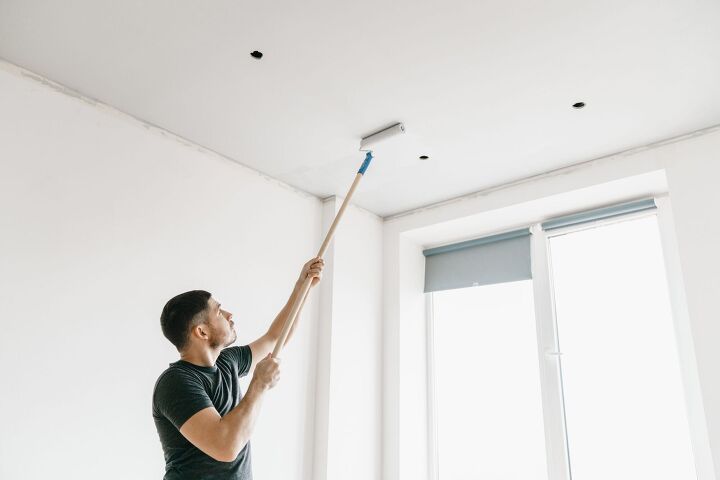Knock-Down Ceiling Vs. Smooth Ceilings (Pros, Cons & Costs)

When it comes to your home’s interior design, it can be challenging to decide how you want to paint your ceilings. This small detail is one that many homeowners overlook while designing their homes. Both knock-down ceilings and smooth ceilings have their own individual benefits and drawbacks. Most designers recommend implementing a textured ceiling when the goal is to make a large space feel smaller and cozier, or to help with soundproofing.
However, neither of these are the top reasons for opting for a knock-down ceiling over a smooth one. The reason why textured ceilings are so popular has to do with the fact that the texturing effect hides cracks and imperfections well. In terms of cost, a knock-down ceiling tends to cost more than a smooth ceiling. This has to do with the work involved.
You can expect to spend between $500 and $1,250 for a knockdown technique on an average ceiling. Meanwhile, a smooth ceiling costs between $450 and $1090. Although there isn’t a huge difference in cost between the two ceiling types, knock-down ceilings will cost more in the long run since they collect dirt and require more frequent cleanings.
If you’re not sure which type of ceiling to choose, we’re here to help. Continue reading for our comprehensive guide on knock-down ceilings vs. smooth ceilings, so that you can make an informed decision about which is the better option for you and your home.
Knock-Down Ceilings
Knock-down ceilings are a form of textured ceiling that is somewhat similar to skip trowel, which gives you a subtle “stuccoed” appearance. This texture involves spraying the ceiling with a watered-down joint compound or spreading blotches of the compound with a trowel and lightly scraping it using a drywall knife. It is arguably the most common type of ceiling texturing.
When the compound is sprayed on, it will drip slightly as it dries and creates “stalactites.” Scraping these stalactites away will leave the ceiling with a stuccoed texture. Like most other ceiling texture options, knockdown is excellent at adding depth to a space and concealing minor imperfections. However, it requires additional labor than alternatives, as you have to manually “knock down” the texture using a trowel.
Pros of Knock-Down Ceilings
- Easy to conceal blemishes. With knock-down ceilings, it’s harder to notice painting imperfections, scratches, waving, etc.
- Reduces noise. Smooth surfaces mean that sound can pass through easier. While knock-down ceilings aren’t nearly as effective as true soundproofing, they can help decrease some of the noise you hear from other rooms.
Cons of Knock-Down Ceilings
- Looks somewhat dated. Although knock-down ceilings are currently used in homes, some view the texture as unappealing or outdated. If you want a more modern, contemporary look, you’ll want to keep this in mind.
- Repairs are challenging. If a section of the ceiling gets damaged, replacement isn’t as simple as repainting. Repairing knock-down ceilings requires a new texture to try and match the existing texture, which can be difficult to achieve without being noticeable.
- Collects dust. Dust has a tendency to cling to the edges of the texture of the ceiling, leading to more frequent dustings and cleanings.
- May have asbestos. If the ceiling was installed prior to 1977, it may contain asbestos.
Complete Guide To Knock-Down Ceilings
Smooth Ceilings
Smooth ceilings also come with their own unique benefits and drawbacks. While you might assume that they are nearly effortless to apply, they often require what’s known as a skim coat. This process involves spreading layers of joint compound using a drywall knife, scraping each layer smooth
While you can certainly accomplish a smooth ceiling by expertly finishing drywall seams, this doesn’t always work in practice. As such, it usually takes at least one skim coat layer to make these seams disappear, unless you’re a skilled drywall taper with many years of experience. Though, if your ceiling is already built and your only concern is finishing it, a smooth ceiling can be done as a DIY project.
Pros of Smooth Ceilings
- Easier to clean and repair. Cleaning is easier since there isn’t any texture to trap dirt and dust. Meanwhile, repairs are also easier because you don’t have to worry about matching texture.
- More modern look. Smooth ceilings are the best way to achieve a modern, contemporary look in your home. Heavier textures, like knock-down ceilings, tend to look very outdated and need replacing quickly.
- Opens up the space. Since smooth ceilings are completely level, they create the illusion of a much higher ceiling. As such, this technique is great for rooms that may feel cramped or are limited in space.
Cons of Smooth Ceilings
- Visible imperfections. With a smooth ceiling, dents, scratches, and other imperfections are more obvious.
- Doesn’t deaden noise. For those who want to reduce the noise from either inside or outside of a space, this type of ceiling is not ideal.
Knock Down Ceilings vs. Smooth Ceilings
When you want a ceiling that compliments the décor and style of your new home, it can be challenging to find the right fit. While knock-down ceilings are excellent at hiding surface imperfections and deadening noise, smooth ceilings can make a room visually appear larger, are easier to clean, and provide a more modern appeal. Let’s explore the differences between knock-down and smooth ceilings in further detail below.
Aesthetics
The appearance of a knock-down ceiling is irregular, resembling stucco on the exterior of a home. This “bumpy” texture is ideal for hiding imperfections on ceilings since it can effortlessly conceal cracks, damage from leaks, defects, and even poor drywall installation.
Whereas, a smooth ceiling, can provide an elegant look to your space and blend seamlessly into your walls. These ceilings also reflect natural light on sunny days, because of the way in which the paint is applied. Another major draw to smooth ceilings is the fact that it visually raises the ceiling, making rooms appear larger, lighter, and brighter.
Application Process
In most cases, a knock-down ceiling is easier to install since there is less prep work involved. However, you still need to properly clean and prime the surface before you can start adding the joint compound. Once prepped, the joint compound is either sprayed, troweled, or rolled onto the ceiling to create stalactite-like peaks. Then, these peaks are flattened using a knockdown knife.
For smooth ceilings, a significant amount of prep work is required beforehand. All cracks, holes, or minor damage has to be filled and since the filler will shrink as it dries, it must be applied past the damaged areas. When dry, the filler has to be sanded down before a base coat can be applied. Once the base coat has finished drying, a skim coat or thin layer of plaster is applied next.
Costs
| Ceiling Type | Average Cost |
| Knock-Down Ceiling | $500 to $1,250 |
| Smooth Ceiling | $450 to $1,090 |
The average cost to have a knock-down ceiling installed is $1.75 a square foot or $875 for a ceiling that is approximately 500 square feet. Though, most homeowners spend between $1 and $2.50 a square foot, or between $500 and $1,250 for the average knock-down ceiling. Whereas, the cost of just the knockdown spray used in the application is $0.26 per square foot.
For a 500-square foot smooth ceiling, the latex paint and primer (all in one) costs between $140 and $380. In regards to labor, you’ll pay around $280 to $680. Additional costs for ceiling paint supplies, such as masking tape, paper, and cleanup supplies, costs are $30. This brings the total cost for a smooth ceiling to between $450 and $1,090. All of these costs are reflected in the table below:
| Paint & Primer | $140 to $380 |
| Labor | $280 to $680 |
| Additional Painting Supplies | $30 |
| Total Cost for Smooth Ceiling | $450 to $1,090 |
Repairs
While you can certainly repair holes in a knock-down ceiling, it won’t be easy to blend the existing texture with the texture of the repair. Even with a good quality repair job, it’s very difficult to get the ceiling and the repair to match perfectly. A smooth ceiling, on the other hand, is much easier to repair since damaged sections can be removed and a new drywall piece can be put in its place.
Maintenance
The rough texture of knock-down ceilings makes maintenance a challenge. Dirt, dust, and cobwebs can attach easily to the crevices and bumps of the texture, making cleaning a more involved process. Running a feather duster is one way to efficiently clean knock-down ceilings, though you can also use the brush attachment on a vacuum to gently clean the ceiling.
Smooth ceilings are just naturally much simpler to clean and maintain since they are completely flat. Not to mention, they are most recommended for use in kitchens and bathrooms, as excessive moisture can be absorbed by the knockdown texture and cause it to loosen and fall over time.
Noise
Knock-down ceilings, and also other types of textured ceilings, are better at noise dampening than smooth ceilings since they have additional surface area. In fact, if you have any areas of your home where noise is an issue, consider opting for a knock-down ceiling over a smooth one.

Jessica considers herself a home improvement and design enthusiast. She grew up surrounded by constant home improvement projects and owes most of what she knows to helping her dad renovate her childhood home. Being a Los Angeles resident, Jessica spends a lot of her time looking for her next DIY project and sharing her love for home design.
More by Jessica Stone











![10 Best Scroll Saws for 2022 [Ultimate Reviews & Buyer's Guide]](https://cdn-fastly.upgradedhome.com/media/2023/07/31/9070684/10-best-scroll-saws-for-2022-ultimate-reviews-buyer-s-guide.jpg?size=350x220)




![10 Most Dangerous Neighborhoods in Baltimore [Updated]](https://cdn-fastly.upgradedhome.com/media/2023/07/31/9075655/10-most-dangerous-neighborhoods-in-baltimore-updated.jpg?size=350x220)











